CLASSIFICATION - PowerPoint PPT Presentation
1 / 20
Title:
CLASSIFICATION
Description:
CLASSIFICATION * * * * * * * * What is Classification? The grouping of things according to similar characteristics Geologists classify rocks, soil, and fossils ... – PowerPoint PPT presentation
Number of Views:816
Avg rating:3.0/5.0
Title: CLASSIFICATION
1
CLASSIFICATION
2
What is Classification?
- The grouping of things according to similar
characteristics - Geologists classify rocks, soil, and fossils
- Meteorologists classify clouds, winds, and
storms. - Biologists classify living things
3
The First Taxonomists(scientists who classify
living things)
- Aristotle Developed the first classification
system based on organisms being placed in two
groups plants and animals - Animals were subdivided into the way they
moved walking, swimming, flying - John Ray Suggested that groups with the same
kind of parent should be grouped in a species - He used an organismss internal anatomy as
well as its outward appearance to classify
organisms. - Carolus Linneaus Developed the classification
system we use today called binomial nomenclature
4
Binomial Nomenclature
- A organisms first name is its genus
- (similar to our last names)
- Its second name is its species
- (similar to our first names)
- Examples Panthera leo, Homo sapiens, Felis
domesticus, Felis tigris, Canus lupus - Genus is capitalized, species is lower case and
both are in italics or underlined
5
Classification Groups
- Kingdom (largest, most general)
- Phylum
- Class
- Order
- Family
- Genus
- Species (smallest, most specific)
6
Classification Vocabulary
- Unicellular the organism only has 1 cell
- Multicellular the organism is made of many
cells - Prokaryotic the cells of the organism does NOT
have a nucleus - Eukaryotic the cells DO have a nucleus
- Autotrophs organisms that make their own food
(producers) - Heterotrophs organisms that must consume food
for energy (consumers)
7
The Six Kingdoms
- Archaebacteria
- Eubacteria
- Protista
- Fungi
- Plantae
- Animalia
8
Kingdom Archaebacteria
- Most likely the earliest forms of life on earth.
- Can live in extremely harsh environments like
lava and boiling hot water - Unicellular
- Prokaryotes DNA lies free in the cytoplasm of
the cells because there is not nucleus - Heterotrophs
- Reproduce with cell division
9
Kingdom Eubacteria
- Typical bacteria
- Prokaryotic
- Live in mild, oxygen-rich environments
- Some have cell walls that are rigid like plants
- Heterotrophs
- Reproduce with cell division
10
Kingdom Protista
- Unicellular organisms that sometimes live close
together in colonies - Eukaryotic
- Live in water or really moist environments
- Grouped by the way they move
- Most heterotrophs, but some are autotrophs
- Reproduce with cell division
- Examples euglena, amoeba, paramecium
11
Kingdom Fungi
- Most are multicellular, but a few like yeasts are
unicellular - Heterotrophs. They digest food outside their
bodies then absrob it through their cells - Eukaryotic
- Live in mild, moist, dark environments
- Do not move
- Examples yeast, mold, mushrooms
12
Kingdom Plantae
- Multicellular
- Cells have thick cell walls that support the
plant - Autotrophs require photosynthesis to produce
their own food - Eukaryotic
- Can live in a variety of conditions
- Examples flowers, grass, trees, weeds
13
Kingdom Animalia
- Multicellular
- Cells are organized into layers called tissues
that make up organs, which make up organ systems - Heterotrophs
- Eukaryotic
- Can live in a variety of conditions
- Examples humans, cats, dogs, penguins,
giraffes, lizards, fish, birds
14
Vertebrate Classes
- Animals that have backbones are further
subdivided into 5 vertebrate classes - Mammals
- Birds
- Fish
- Reptiles
- Amphibians
15
Mammals
- Warm-blooded
- Have hair
- Produce milk for their young
- Do not lay eggs
- Young develop inside their mothers
- Examples humans, elephants, monkeys, hippos,
gophers
16
Birds
- Have feathers
- Most Fly
- Hollow bones
- Warm-blooded
- Lay eggs
- Examples penguins, owls, eagles
17
Reptiles
- Have scales
- Most lay eggs
- Cold-Blooded
- Examples turtles, alligators, crocodiles,
snakes, lizards
18
Amphibians
- Born in water
- Breathe with gills until mature and move to land
- Lay eggs
- Cold-Blooded
- Examples frogs, toads, salmanders
19
Fish
- Live in water
- Breathe using gills
- Most have scales
- Cold-Blooded
- Examples Goldfish, koi, sharks
20
What about Viruses
- What is a virus
- A strand of DNA in a shell made of protein
- They are not included in any of the kingdoms
because they have characteristics of both living
and nonliving things - Examples AIDS/HIV, common cold, HPV, herpes































